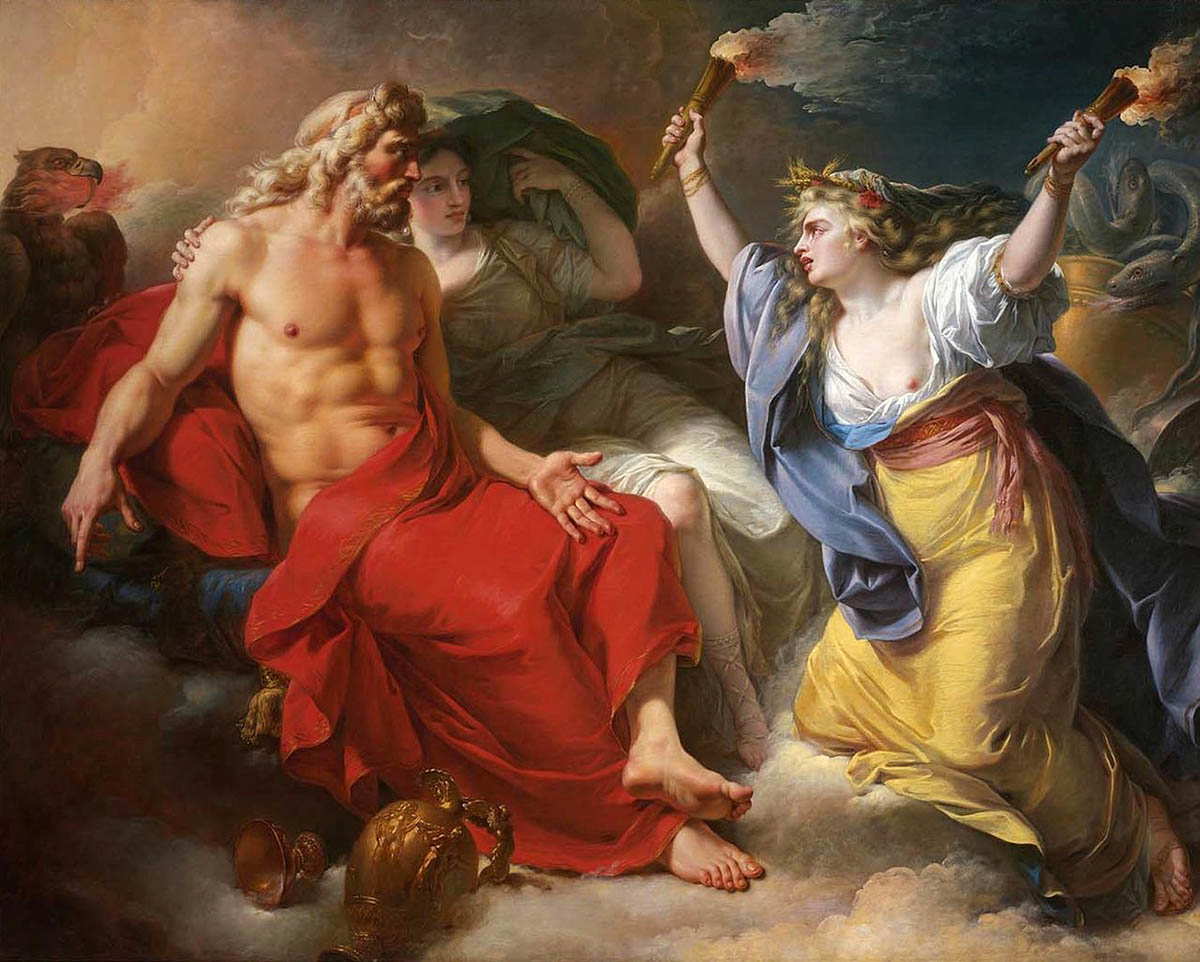
Ever wondered whom you should thank for the invention of cereal? Well, for the ancient Greeks, that would be Demeter. As the goddess of grain and agriculture, among other things, Demeter brought life to crops and blessed her worshippers with a bountiful harvest.
Demeter and her myths also represent many different types of cycles. The most obvious is the cycle of the seasons: from summer to autumn to winter to spring… and back again. One of her major myths is the story of Demeter’s loss of her daughter. In this example, the cycle is one from grief to acceptance, showing how grief can return and fade away again and again. Demeter’s myth is also a type of mother story, describing the inevitability of a child “leaving the nest”.
Who Is Demeter?

The beginning of Demeter’s storyline is shared with her siblings. She was born of the union between Kronos and Rhea: Hestia was the eldest sister, then came Hera, then Demeter. After the sisters were born, then came the brothers: first Hades, then Poseidon, and finally the youngest, Zeus.
This was quite the dysfunctional family. Kronos decided to eat all of his children for fear of their potential power in the future, but Rhea managed to trick him by giving him a swaddled stone instead of Zeus. Zeus was raised in secret, and when strong enough, he came back to save his siblings from the stomach of their ravenous father. He gave Kronos a magical concoction that forced him to barf up his siblings. Zeus’ brothers and sisters sprung out, fully grown, and ready for revenge.
Get the latest articles delivered to your inbox
Sign up to our Free Weekly NewsletterTogether, Demeter and her siblings overthrew Kronos, and Zeus was established as the new leader of the immortals. The age of the Titans was over, and the age of the gods began. Soon after this, the gods received their titles. Demeter became the goddess of agriculture. She taught humans how to plant, plow, and nurture the earth to provide food. Her Roman name was Ceres, which is where we get the word “cereal” from.
Teaching Humans: Triptolemos & Demeter’s Favor

Demeter is often depicted in art as a mature woman, and her myths illustrate her as a maternal and generous goddess. Her attributes are a plentiful cornucopia, sheaves of wheat, and a torch. The beginning of humankind’s adventures in gardening and agriculture began with Demeter’s favorite hero: Triptolemos. Demeter gifted Triptolemos with her knowledge so that he could impart it to his fellow humans.
“She [Demeter] was the first to cut straw and holy sheaves of corn-ears and put in oxen to tread them, what time Triptolemos was taught the good craft.”
(Callimachus, Hymn 6 to Demeter)
When Demeter was grieving the loss of her daughter, she wandered around Greece from town to town in search of her. She eventually came to Eleusis. Demeter was traveling in the guise of an old woman, her grief represented by her aging and weak form. Here, she was greeted and comforted by the kind-hearted Triptolemos, a young prince. To show her appreciation for his hospitality, she taught him how to work the land.
“For Triptolemos […] Demeter prepared a chariot of winged dragons, and she gave him wheat, which he scattered all over the populated earth as he was carried along through the sky.”
(Pseudo-Apollodorus, Bibliotheca 1.32)
A Mother’s Loss: Demeter and Persephone

Demeter’s myths have a sense of familiarity to them for many people. One of her most well-known myths is the one in which Persephone, her daughter, is taken by the Lord of the Dead, Hades. The myth is an allegory for the experience of mothers in ancient Greece who had to give up their daughters to marriages, over which they had no control.
The myth begins with Persephone in a meadow picking flowers. As the daughter of Demeter and Zeus, she was an immortal being herself. Persephone was the goddess of springtime, and her connection to agriculture meant that she was worshipped alongside her mother in the Eleusinian Mysteries. This was a secret cult that would perform as yet still unknown rituals in honor of the goddesses.
As Persephone was choosing flowers, the god Hades burst forth from the earth below and took her back to his kingdom in the Underworld. When the news of Persephone’s disappearance reached her, Demeter was aghast: she knew not who had taken her daughter and so she spent many months searching the earth for her. Demeter held a torch throughout her entire search, and so this became the symbol of the weary and grieving traveler.
The Father Override & Demeter’s Grief

For many women in ancient Greece, Demeter and Persephone’s myth could easily be empathized with. It was an illustration of how a daughter was given in marriage by a father to another man. Unbeknownst to Demeter, Hades had in fact asked Zeus, Persephone’s father, for Persephone as his bride. This was in keeping with ancient Greek culture and practice. Zeus had agreed, but he believed Demeter would not be pleased with her marrying the Lord of the Dead. To Demeter, Hades’ domain was a dark and damp land where nothing could grow and thrive. This was the opposite of Demeter’s spirit.
When Persephone was taken, Zeus and the other gods who knew the culprit behind Persephone’s abduction were too fearful and trepid to tell Demeter. Demeter was distraught at the absence of Persephone and began to affect the earth. The land, which was once bountiful, began to grow hard and increasingly infertile. The sun began to weaken, and cold blustery winds and freezing temperatures prevented crops from growing. This was the change from summer to autumn, and finally to winter.
Eventually, Helios and Hecate came to Demeter’s aid and told her that it was Hades who had taken Persephone and that he had had the permission of Zeus. Demeter in anger continued the famine. She traversed from town to town for many days, punishing those who rejected her and blessing those who took her in.
Demeter’s Power

As time went on, Zeus began to fear for the human race, as they could not grow any food. He summoned Demeter to Olympus and demanded that she stop her effect on the land. Demeter vowed that she would only stop the famine and cold weather if her daughter was returned to her.
“She was wasting away with yearning for her daughter…
She made that year the most terrible one for mortals, all over the Earth, the nurturer of many.
It was so terrible, it makes you think of the Hound of Hades. The Earth did not send up any seed. Demeter, she with the beautiful garlands in her hair, kept them [the seeds] covered underground.
Many a curved plough was dragged along the fields by many an ox — all in vain.
Many a bright grain of wheat fell into the earth — all for naught.
At this moment, she [Demeter] could have destroyed the entire race of humans with harsh hunger…”
(Hymn to Demeter)
Zeus had no choice but to try and meet Demeter’s demand. Her power and influence on the earth was too powerful to ignore. Her flaming torches were a sight to behold, too.
Pomegranates and Time Shared

So, Zeus relented and relayed the message to Hades. Hades agreed to let Persephone return to her mother, for the sake of humankind. However, during their final time together before Persephone left the Underworld, Hades gave Persephone a pomegranate.
Now, it was common knowledge to the immortals that to eat anything from the Underworld would mean that the consumer would never be able to leave. Persephone — some say she knew about this magic, some say she did not — ate a third of the pomegranate. Did she want to stay with Hades? Did she enjoy life as Queen of the Underworld rather than a nymph of the forest? Perhaps she chafed under her mother? Or perhaps she missed the life of the living, but also enjoyed the Underworld? Or was Persephone cruelly tricked to remain in her prison? It’s open to interpretation.
In any case, Persephone had eaten the pomegranate. Demeter managed to argue her daughter’s case and bargained with Zeus. The outcome was this: Persephone would return to and stay in the Underworld with her husband every year, for a third of the year. For the rest of the year, she could be with her mother and the land of the living. It is safe to say, Demeter and her son in law did not have the best relationship.
Eleusinian Mysteries

These cycles — a mother and daughter reunited and separated over and over, the re-occurrence of grief to acceptance, the descent into the land of the dead, and the ascent to the land of the living — represented Demeter and the seasons’ cyclical nature. When Persephone is in the Underworld, winter descends. Slowly, as Demeter grows happier at her daughter’s impending return, we step into spring. Summer blooms as mother and daughter are reunited. Autumn begins to creep in again as Demeter gloomily relinquishes her daughter to the Underworld again.
The Eleusinian Mysteries were huge for Demeter’s worshipers and their rituals. The Mystery ritual would involve a re-enactment of the cycle: Persephone’s abduction, “the descent”, then the “search” and finally the reunion or the “ascent” from the Underworld. Not much is known about the Mysteries other than that any citizen who was invited to join must keep the practices of the Mysteries a secret. The first rule about the Mysteries: Don’t talk about the Mysteries. To tell was punishable by death.
Demeter & Her Wrath

Demeter was sometimes taken for granted, as she was not seen as a militant goddess like Athena, or as malicious as the Queen of the Gods, Hera. Most of the time, she was kind but instructive, helping humans with their farming tasks.
A man named Erysichthon underestimated her composed nature. He destroyed one of Demeter’s sacred groves by chopping down all the trees. Not only this but there was a time when the axmen refused to cut down the final tree. On this tree were symbolic wreaths for every favor Demeter had ever bestowed on humans. Erysichthon foolishly took an ax and chopped the tree down. Inside the tree was a dryad, a tree spirit… as the spirit died, she cursed the foolish man.
More than happy to do so, Demeter took up the dryad’s curse and chose to enact it. Using her powers as a goddess, she affected his body so that he had an insatiable hunger. The more he ate, the hungrier he felt. Eventually, after spending all his money, selling all his belongings, and even selling his own daughter into slavery, he finally ate his own body!
Demeter was hardly underestimated or insulted in such a way again. She was one of the most worshipped immortals because her power and influence was necessary for the survival of humankind.
“I am Demeter, the holder of honour. I am the greatest
boon and joy for immortals and mortals alike.”
(Homeric Hymn to Demeter)








